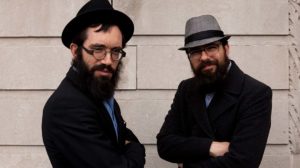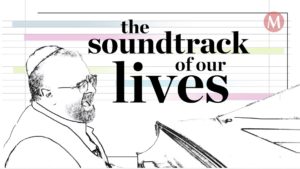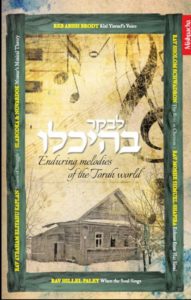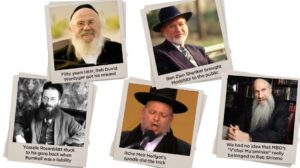Many Strings to Their Bow

The Tzuf Family Band, with their harp, flutes, lyres, and drums, creates healing vibes for a sometimes off-key world

Photos: Menachem Kalish, Family archives
Nestled in the valley among the rolling green hills of the northern Galilee, just a few minutes from Meron, lies the settlement of Safsufa, and there, in a sprawling rustic home surrounded by trees and flowers, live the Tzuf family — Simcha Binyamin, Chaya Rachel, and their five children. Their lounge is cozy, decorated with colorful ethnic rugs and wall hangings, musical instruments strewn all around like part of the furniture, the wood fire casting a comforting orange glow. It’s the perfect backdrop for the music that emerges from between these walls: meditative, spiritual, soulful, penetrating. And for the Tzuf band, it’s also a family affair.
“Music has been a part of my life for as long as I can remember,” Simcha relates. “It’s where I discovered my inner healing.” He grew up playing piano, guitar, and harmonica, and learned to improvise and compose original music as well. With a musical wife as well, the Tzuf children have inherited the talent and passion, and their ensemble, the Tzuf Family Band, has created its own niche and style.
Simcha tells of some of the challenges he had growing up, despite a warm and happy home, and how music got him through — and he’s happy his own children have that outlet as well. He was born and raised in Los Angeles’s Pico Robertson neighborhood, where his father, Rabbi Irwin Katsof, started the local Aish HaTorah.
As his father was an Aish HaTorah rabbi, Simcha grew up in a very kiruv-oriented household — there were always people coming over for Shabbos, after the popular davening at Aigh HaTorah, and most of the week, too.
But then, for Simcha at least, everything changed. When he was nine, his family moved to Wesley Hills in Monsey, New York — and Simcha hated it.
“New York was a shock to me,” he remembers. “I went from being a popular kid to one who was teased all the time, for my accent, for everything. I had a tough time in school.”
Simcha attended yeshivah, but dropped out after eighth grade. “I just didn’t feel at home there. I didn’t feel any spirituality. There were over a hundred kids in each grade — they didn’t even get a chance to teach us the meaning of the words in davening — and davening is supposed to be our most intimate connection with Hashem.” (He admits that when he dropped out, it was a situation of mutual agreement.)
Then he learned for half a year at a different yeshivah high school, trying to find himself. “I was a sad teenager,” he remembers ruefully. “No one could figure out how to help me. I remember they sent me to talk to someone, and I didn’t know what to say, so I just cried.”
But music was his redemption. “I was the keyboardist for the Pey Dalid band — they were in their thirties and I was just 15. But I didn’t care. Music was my outlet — it was so therapeutic for me.”
Music runs in Simcha’s blood. His progenitors include professional pianists, a saxaphone player, a violinist, and a Yiddish singer. His grandmother passed on the love of music and the passion for it to Simcha’s mother, who in turn, passed it on to him.
“My mother believed in me and wanted me to connect with music, encouraging me to follow my own passion for music. It’s really in her zechus that I play.”
Pathways to Connection
At 15, Simcha came to Israel on his own. His older brother was already learning in Tzfas, in the American-oriented Shalom Rav yeshivah, and he also had a cousin learning in Shalom Rav’s sister seminary for girls, Sharei Bina.
“They told me, ‘Come to Tzfas — you’ll love it and everyone will love you!’ I didn’t believe them but it was true. I fell in love with everything about Tzfas — up in the clouds, blue everywhere, so many colors, hidden alleyways — no matter how long you live in Tzfas, there are always more alleyways to discover.”
Simcha felt comfortable in Tzfas — but his parents weren’t so comfortable about his particular situation. He wasn’t learning in yeshivah, and he was living in one of the many abandoned ruins in Tzfas’s Old City and hanging out with a bunch of hippies.
“These were guys living freely, connecting to nature. They were spiritual, but maybe a bit too free — all peace and love but no real purpose. We did a lot of sitting around the fire and singing, which was all very nice, but even then, I realized that there had to be more to life than that — I needed something more.”
One good thing about this period was that it entrenched Simcha in his music. “I couldn’t shlep around a piano, but I got hold of a guitar, and also taught myself to play flute.”
And then he discovered Breslov, which, he explains, gave him a pathway to connect his love of music and nature to Torah. At the same time, his future wife was on a similar journey via a roundabout route of spiritual exploration and back to Torah, also coming from a family who were baalei teshuvah.
Simcha says that for him, music is that elusive connection he always craved. “It helps me connect to my neshamah,” he explains. “And that means connecting to Hashem. In the Beis Hamikdash, music was a big part of avodas Hashem — there was always that combination of music and prayer. For me, music is an essential part of my avodah.”
When Simcha and Chaya Rachel first started seeing each other, music was the glue. “Back then he used to play the flute, and I would hear him coming, playing his flute. There was such a strong musical connection between us,” says Chaya Rachel.
Chaya Rachel, who is half Ashkenazi, half Turkish, is also a talented and accomplished musician. She plays guitar, various drums, and a number of Turkish instruments, which she plays in a women’s musical ensemble that takes ancient Turkish melodies and fits words of kedushah to them.
The two had their shared love of music, but then life happened. They got married when they were just 18, the children came along one after another, and music inevitably took a back seat to making a parnassah, raising the kids, and generally just living. They’d always dreamed of owning a harp. Harps, however, are not cheap. (An intermediate harp can cost up to $5,000, and a full-size professional harp is at least $50,000). But then one day the Tzufs got an unexpected check in the mail and their life changed. They decided to splurge on a harp.
Chaya Rachel (who at one point added the name Avital but prefers her birth name) went to learn music at Tzfas’s Maqamat Academy of Eastern Music. But it was the harp that grabbed Simcha’s heart and soul.
“A harp is like the heart of a piano. If you open up a piano, what you see inside looks very much like a harp. And a harp is always open, like the sustain pedal of the piano, which makes the notes go on and on. It creates a space.”
The sound of a harp is indeed ethereal and magical — perfect for relaxation and meditation. As Simcha puts it, “The harp has such a healing beautiful sound and always seems to bring a smile to people’s faces, or tears to their eyes. It’s a magical instrument that helps people connect with themselves and others.”
Strings in the Wind
While the sound of a harp is indeed unique, Simcha and his wife have come up with an even more unusual sound — the wind harp, historically known as the Aeolian harp. The idea was actually born out of what is often a frustrating problem for harpists. When playing outside, the strings of the harp are so sensitive that the wind blowing through them actually creates a sound — the wind is literally playing the harp. The resulting effect, although it gets in the way of the harpist playing his own tune, is actually entrancing.
“We were blown away,” Chaya Rachel remembers. The harp playing in the wind reminded Simcha of Dovid Hamelech, who, according to Midrash, would place his harp in his window so that the wind playing the strings would wake him in the middle of the night in order that he could sing praises to Hashem. Simcha decided to do the same thing: He put his harp in the window of his workroom and switched on his recorder. The results were amazing — an ethereal sound that has an incredibly relaxing, healing effect.
In fact, says Simcha, that healing effect isn’t so surprising. “I tuned the harp to the pentatonic scale, the same scale which is used in music therapy as its therapeutic value is well-known. No matter what note is played in this scale, it sounds musical. The sound has a certain magical feel to it.”
The pentatonic (from the Greek “pente,” five) scale effectively gives all the harp strings the sound of just five notes, and, interestingly, there are sources that suggest that Dovid Hamelech had a harp with five strings. Perhaps that is the root of the magical sound.
Simcha took the idea a few steps further. He took his harp outside and put it in a field above the Mediterranean Sea. The wind was strong and created wondrous sounds from the harp, with bird song and the gentle lapping of the waves in the background. Simcha feels that the wind harp has so much potential that he hopes to bring it to groups for live meditation.
Aside from Simcha’s wide-ranging proficiency in instruments, his wife Chaya Rachel plays the baglama, a small Turkish guitar, and a variety of drums, including the deep-toned frame drum — believed by some to be the kind of drum played by the prophetess Miriam. Nachman, at 15, is an expert on the side flute and naturally and effortlessly (at least that’s what it looks like) harmonizes with his parents’ melodies on whatever instrument they happen to be playing. Thirteen-year-old Ora loves the Miriam drum, while ten-year-old Sarah plays piano and ukele and is in charge of the filming. Eight-year-old Nehori loves piano and drums of any kind — the wave drum he demonstrated really does produce a sound like that of rolling waves. And six-year-old Daryah enjoys picking up and trying out whatever instrument is lying around.
Small Is Also Good
The Tzufs perform at an eclectic mix of venues, from weddings of secular Israelis to those of young Chabad chassidim whose families live in the north, and Simcha’s kumtzitzim are popular with the yeshivah crowd, tourists, and family groups. Recently he performed at the sheva brachos of the son of the Biale Rebbe.
The type of music the Tzufs perform may be a little different than the regular musical fare offered up at regular frum weddings, but, Simcha claims, the chareidi public is more open to a wider range of music styles.
But harp music, as mellow and relaxing as it is, isn’t really the kind of sound you can dance to at a wedding. So the Tzufs use a wide variety of instruments to suit the moment, including various types of guitars and drums.
“It’s different every time,” Simcha explains. “Often it’s free playing — we have a set list of songs so we know what we’ll be playing, but we go with the flow, like a conversation through music. We play whatever people ask for — we find out what they like and bring those influences into the music. For functions we’ll play a lot of traditional Jewish niggunim, Carlebach, chassidic, whatever seems to go.”
Most of their music is instrumental, although Simcha does sing occasionally, and will sometimes play his own compositions. Simcha also has his own band, the A.D.D. Project, who also play at weddings — sometimes in coordination with the family band — providing a lively mix of rock, funk, and blues with a Jewish flavor.
The past year, with the endless lockdowns and restrictions, has been a challenge for everyone, and especially so for people like the Tzufs who make their parnassah from events that have been banned or severely restricted, like weddings. The ubiquitous “corona weddings,” held in a back yard with just a handful of guests, have been both praised and criticized by participants, but how is it for the band? Instead of playing to a crowd of hundreds, the corona wedding band’s audience number no more than a few dozen. An interesting experience, says Simcha, and not all that bad. In fact, he says, they’ve been rather nice.
“It’s a challenge, but these kinds of weddings actually suit a small band like ours. The big box speakers actually drown out the delicate sound of the harp. These weddings really do feel more intimate, and more holy.”
You might think that piano, harp, and flute would be quite enough musical instruments for one family. But casually lying around the living room, clearly very much a daily part of family life, is a bewildering collection of all kinds of weird and wonderful instruments. The odd-looking African harp, which is made from a huge gourd and covered in cow-skin, with the neck of a guitar stuck into it, is called a “niggoni” in the native African language (curiously close to the Hebrew word “niggun”). Perched in the corner of the room is a “mini” harp, used for traveling, and on a wooden stool is a Russian violin called a gudok— reminiscent of its better-known cousin, yet with its own distinct character. Other interesting instruments include a jura — a small Turkish string instrument — and a Native American flute, which produces a haunting sound that, blended with the harp music, induces meditation.
These instruments are clearly the Tzufs’ friends, intimate and familiar. The family members pick up various instruments at random and give an impromptu demonstration, each one effortlessly harmonizing with the others, creating a magical mystique in the room. The impro session moves out into the yard — the Tzufs are always happy to play their music in the middle of nature — accompanied by the family dog and various cats wandering across the grassy stage.
Power to Heal
Simcha is always on the lookout for ways to reach others through music’s phenomenal power. He teaches music through improvisation, instructing students how to learn songs by ear while making to keep the pressure down.
“There are so many musical children who think they’re not musical because they didn’t fit in with the standard music teaching methods,” he explains. “But actually, just like there are students in school who are smart, intuitive, and unique, but don’t do well in school because they think differently, the same applies to music education. My goal is to teach music to people who might not relate to reading music, but do want to connect with their inner music. I want parents to understand how much music lessons can do for a child. And I want anyone who has been told their whole life that they can’t play music, that they’re not talented and it’s not their thing, to know that it’s not true. Music is accessible to anyone who has a passion for it.”
Simcha is bringing his music to healing as well, having decided to become certified as a clinical bedside music therapist — a decision partly the result of a very moving personal experience indicating the very real healing power of music. A few years ago, the family of a man in a coma called up Simcha and asked him if he could play for their relative, believing the music might be able to reach him and help him come around. Naturally, Simcha obliged, but he never heard what happened afterward, and never followed up. He presumed the man had passed away. But just recently, Chaya Rachel fortuitously bumped into the people who brought Simcha to the hospital two years ago. They told her that their relative had suddenly woken from his coma that same night that Simcha had played for him, and is now completely healthy.
Personal Gifts
Just like Simcha’s inner drive to improvise with his music, he’s taken his other career — that of a qualified sofer stam — in a more artistic direction as well. He’s now in the middle of writing two sifrei Torah, a holy endeavor for which he’s ever grateful, but there is a part of him, he says, that wanted to take that writing to a place of art. In addition to his safrus, he also produces a range of items with various pesukim written on them, from beautifully illustrated kesubos to coffee mugs.
“For me personally, there was a certain frustration in writing in the way of the traditional sofer, one mezuzah after another,” he says. “Just like with music, I realized that the gift Hashem gave me was to create. So instead of giving up or forcing myself into something too rigid for my nefesh, I felt I needed to re-attune, like the analogy Rebbe Nachman quotes from the Zohar about the coal that needs to be shaken up to reignite. I’ve chosen to stick with the skill of writing, but I’ve also come to realize that copying letter by letter isn’t the end-all of my gift. Taking my safrus to a place of art is part of my journey, of finding a way to take Hashem’s gifts and make them flourish.”
The Tzufs have decided to pursue their parnassah via their music and inspired art, “although people kept telling us we couldn’t make a living from it,” Simcha admits. “But I strongly believe that what you can bring to the world, the gifts with which you’ve been bestowed, is also what can bring you shefa, bounty. Music is so healing and redemptive for me. It guided me in my life. It picked me up when I was down, and gave me something strong in myself to believe in. I believe it can work for others too, and we can all share the bounty.”
(Originally featured in Mishpacha, Issue 858)
Oops! We could not locate your form.













